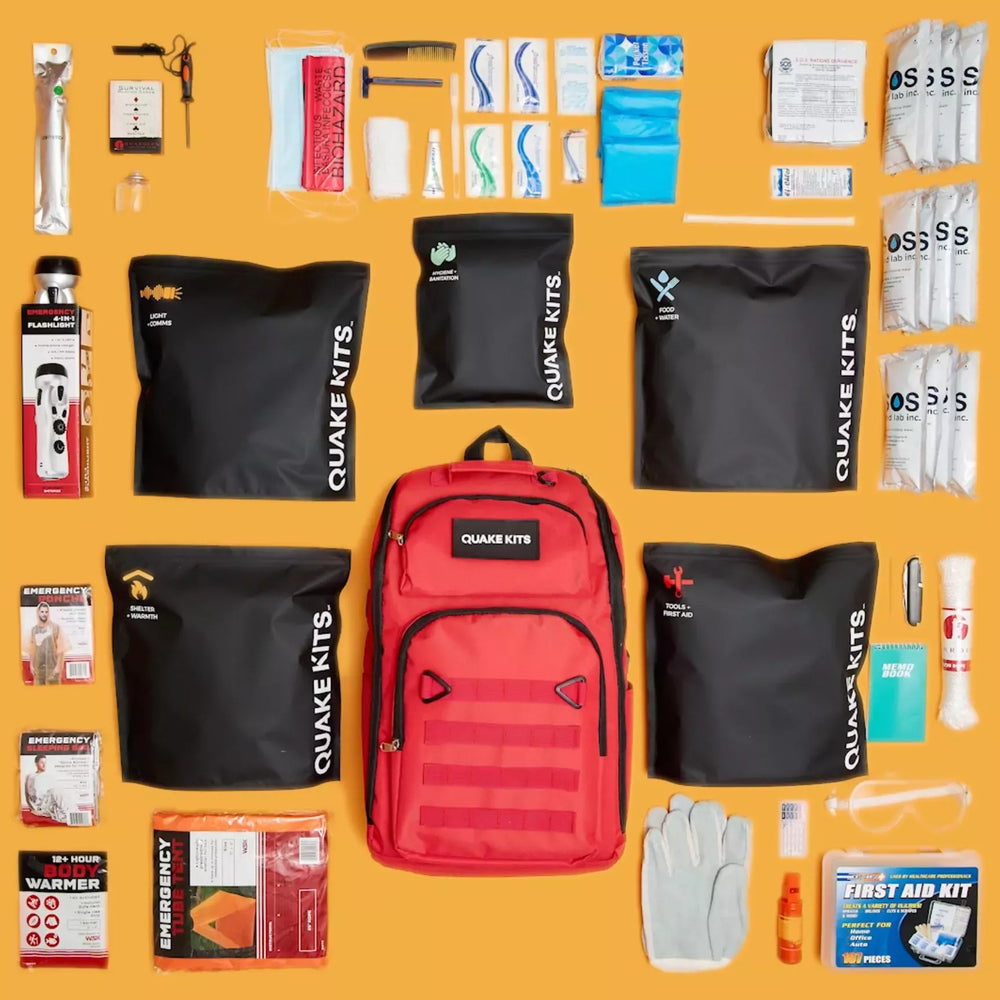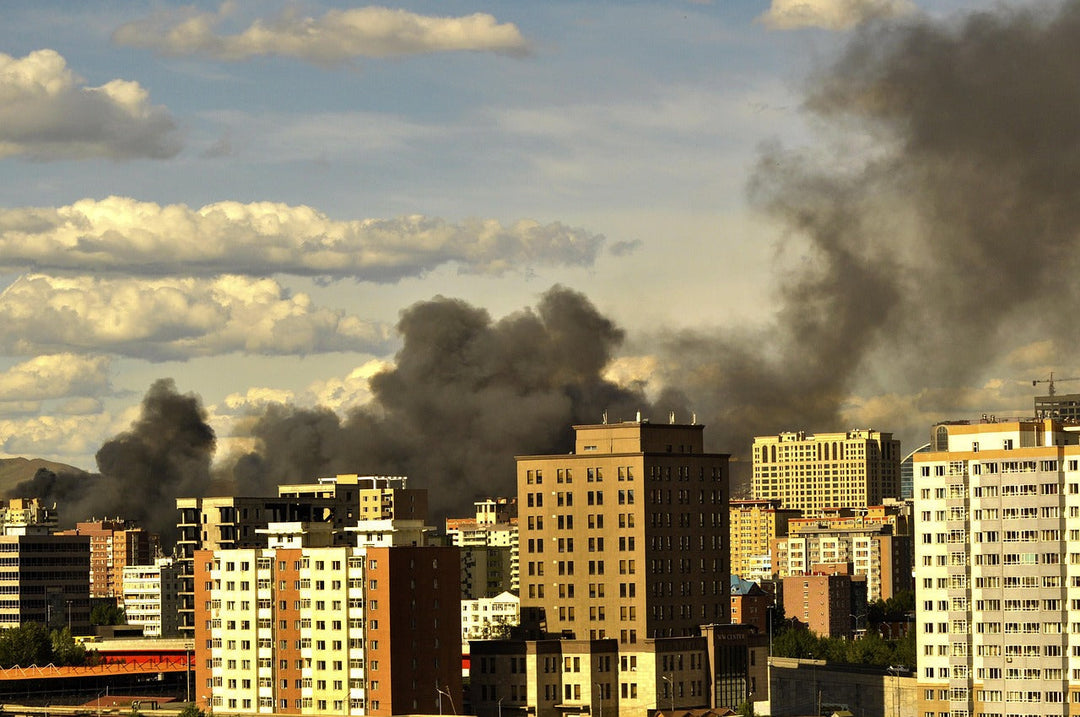Cómo preparar a tu mascota para un desastre
Cómo preparar a tu mascota para un desastre
Las emergencias pueden ocurrir en cualquier momento, y si bien solemos prepararnos para nosotros mismos, nuestras mascotas también necesitan protección. Sin un plan, las mascotas corren el riesgo de sufrir lesiones, perderse o algo peor. Ya sea un terremoto, un incendio forestal, un huracán o un fenómeno meteorológico severo, prepararse con anticipación puede marcar la diferencia. Aquí te explicamos cómo garantizar su seguridad antes, durante y después de un desastre.
Descubre cómo Quake Kits ofreció una mano amiga a nuestros amigos peludos durante la tragedia de los incendios forestales de Los Ángeles.
Antes de un desastre: Planifique con anticipación
-
Identificación: Asegúrese de que su mascota lleve un collar con placas de identificación actualizadas y un microchip registrado. El microchip es una de las formas más efectivas de reencontrarse con su mascota en caso de separación. Verifique que sus datos de contacto estén actualizados en el registro del microchip.
-
Kit de emergencia: Prepare un kit de emergencia para su mascota con artículos esenciales como comida, agua, medicamentos, una correa y un transportín. Guarde el kit en un lugar de fácil acceso y revíselo periódicamente para comprobar que no haya artículos caducados. Nuestros kits para perros y gatos son ideales para garantizar que su mascota tenga los suministros necesarios, ya sea durante un confinamiento en casa o una evacuación.
-
Plan de evacuación: Sepa dónde llevará a su mascota si necesita evacuar. Muchos refugios de emergencia no aceptan mascotas (excepto animales de servicio), así que busque hoteles que admitan mascotas, residencias caninas de emergencia o acuerde con familiares o amigos un lugar seguro con anticipación.
-
Transporte: Tenga a mano una correa y un transportín cerca de las salidas y practique la evacuación con su mascota para reducir el estrés en caso de una emergencia real. Los transportines deben ser resistentes y estar bien ventilados para garantizar la seguridad durante el viaje.
-
Registros médicos: Guarde copias de los registros de vacunación y médicos de su mascota en una bolsa impermeable. Algunos refugios de emergencia o residencias caninas pueden requerir comprobante de vacunación.
Qué incluir en el kit de emergencia para mascotas
-
Alimentos y agua para al menos dos semanas almacenados en recipientes herméticos e impermeables.
-
Medicamentos y copias de los historiales médicos, incluyendo el comprobante de vacunación.
-
Correa, collar y arnés (los collares reflectantes son ideales para la visibilidad en condiciones de poca luz).
-
Transportín o jaula con ropa de cama para mayor comodidad
-
Bolsas para desechos y arena para gatos
-
Artículos familiares como juguetes y mantas para reducir el estrés
-
Información de contacto de su veterinario, refugios de animales de emergencia y amigos o familiares de confianza.
Durante un desastre: Mantén a tu mascota a salvo.
-
Evacúen juntos: Nunca abandonen a su mascota. Si no es seguro para ustedes, tampoco lo es para ella. Dejarla atrás la expone a un grave riesgo de lesiones, condiciones peligrosas o de extraviarse.
-
Refugio en el hogar: Elija una habitación segura y libre de peligros, como objetos punzantes o cables expuestos. Retire cualquier planta tóxica o producto químico que pueda dañar a su mascota.
-
Minimice el estrés: Mantenga a las mascotas en sus transportines o con correa para evitar que huyan presas del pánico. Objetos familiares como mantas y juguetes pueden ayudar a calmarlas.
-
Vigile la salud de su mascota: Las aguas de las inundaciones y los escombros pueden contener bacterias o toxinas dañinas. Si su mascota ha estado expuesta, límpiele bien las patas y el pelaje, y observe si presenta signos de enfermedad.
Tras un desastre: garantizar su bienestar
-
Mantén a tu mascota con correa: El paisaje puede haber cambiado y los olores familiares pueden haber desaparecido, lo que aumenta el riesgo de que se pierda. Mantenla siempre con correa o en un transportín cuando esté fuera de casa.
-
Verifique la presencia de peligros: Antes de dejar que su mascota explore, busque escombros, productos químicos derramados u otros peligros. Los cables eléctricos caídos y el agua estancada pueden representar graves riesgos.
-
Esté atento a los cambios de comportamiento: El estrés puede afectar a las mascotas de manera diferente. Si observa un comportamiento inusual, como que se escondan con frecuencia, agresividad o que se nieguen a comer, consulte con un veterinario.
-
Recursos para la reunificación: Si su mascota se pierde, consulte los refugios locales, publique en las bases de datos de mascotas perdidas y avise a los registros de microchips. Muchos grupos de rescate trabajan para reunir a las mascotas con sus dueños después de desastres.
-
Ayuda a los servicios de emergencia a encontrar a tus mascotas.

Para avisar a los demás de que sus mascotas están en casa, la ASPCA recomienda usar una pegatina de alerta de rescate . Debe ser visible para los rescatistas e incluir información sobre su veterinario y el tipo y número de mascotas que hay en el hogar.
En caso de evacuación con su mascota (si dispone de tiempo), escriba "EVACUADO" sobre las pegatinas. Así, los equipos de rescate no perderán tiempo buscándola.
Kits para terremotos: Apoyo a las mascotas en caso de desastres
En Quake Kits, comprendemos la importancia de la seguridad de las mascotas y nos comprometemos a ayudar a los animales en situaciones de crisis. Tras los devastadores incendios forestales de Los Ángeles, donamos miles de artículos para mascotas a los dueños afectados a través de la protectora de animales. Nuestras donaciones incluyeron juguetes para perros, estacas metálicas para evitar que las mascotas se escaparan, correas reflectantes , collares reflectantes para mayor visibilidad, bolsas para excrementos y comederos . Creemos que toda mascota merece una oportunidad de sobrevivir en una emergencia y seguimos apoyando a los dueños de mascotas en sus esfuerzos de preparación para desastres.
Manténgase preparado y proteja a sus mascotas.
Los desastres son impredecibles, pero con la preparación adecuada, puedes garantizar la seguridad de tu mascota ante cualquier eventualidad. Revisa y actualiza tu plan de emergencia periódicamente y mantén el botiquín de emergencia de tu mascota completo. Cuando ocurre un desastre, estar preparado puede marcar la diferencia.
Si preparar tu propio kit de emergencia para mascotas te resulta complicado, puedes comprar kits ya preparados. Revisa y reemplaza los suministros caducados con regularidad para que todo esté en perfectas condiciones. Un poco de preparación hoy puede salvarle la vida a tu mascota mañana.






Dejar un comentario